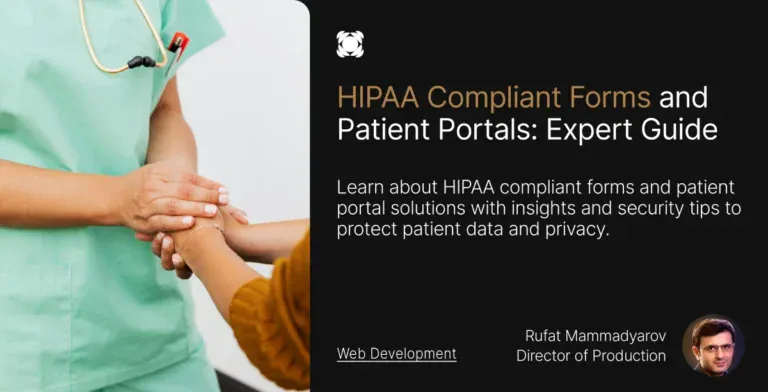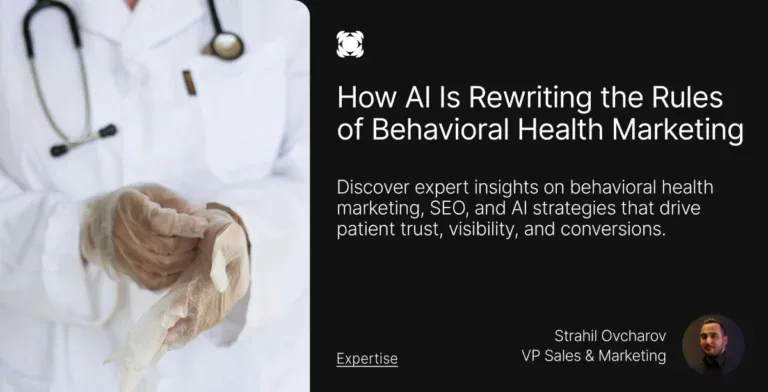When more than 92% of global search traffic comes from Google, it’s very clear that healthcare firms, as a whole, should prioritize digital strategies as soon as possible.
New York’s healthcare scene has many marketing agencies. They help medical practices, hospitals, and healthcare facilities grow. Success isn’t guaranteed, though. About 90% of healthcare startups don’t make it.
Your NYC medical practice faces its own set of challenges. These include serving different patient groups, keeping up with faster-changing healthcare needs, and adapting to new technology.
Modern healthcare consumers do their homework online before making health-related decisions. They look up symptoms, check different providers, and read what others say before scheduling visits. Your healthcare website and organization must develop smart strategies to stand out. Digital presence is crucial now more than ever.
Let’s dive into the digital strategies that drive success for leading healthcare companies in NYC’s competitive market.
Are you trying to build your first digital strategy but don’t know where to start? Let us help.
Local SEO and Google Business Optimization
Local SEO is the lifeblood of digital strategy for NYC healthcare firms that want to connect with nearby patients. NYC’s competitive healthcare market makes local search optimization a must for medical practices.
Key features of local SEO for NYC healthcare
Google Business Profiles (GBP) form the foundation of local search optimization for NYC medical practices.
A complete GBP has an accurate practice name, address, hours, services offered, and high-quality facility photos.

Name, Address, and Phone number (NAP) consistency is another best practice of local SEO. Medical practices should maintain exact business information across all online platforms.
From their website to directories like Yelp, Healthgrades, and Zocdoc. Search engines and patients trust businesses more when they see this consistency.
Patient reviews are arguably the most powerful feature of local SEO for NYC healthcare providers. Medical practices that ask for reviews and respond to feedback seem more trustworthy. This helps attract potential patients and improves visibility in search engines.
Benefits for NYC medical institutions
Local SEO offers NYC medical institutions more than simple visibility. Medical practices can grow in certain areas. Health professionals can bring in more patients by sharing info with locals seeking care.
Local SEO provides better returns than traditional marketing. Local search optimization delivers targeted, trackable traffic, while flyers, radio ads, and newspapers get pricey with low traceability. Healthcare practices can see how many new patients come from each digital channel.
It also helps NYC healthcare firms serve existing patients better, not just attract new ones. Updated hours, accurate location details, and service information make it easier for patients to seek care.
Patient satisfaction scores improve over time with this better accessibility. SEO for urgent care locales has also become a staple for clinics trying to reach more patients.
Tools used for local SEO optimization
Google Analytics and Google Search Console are essential tools for any local SEO strategy. NYC healthcare providers use free tools to check website performance. They see which search terms bring in traffic and find ways to improve.
Local rank tracking tools with geo-grid functionality show NYC medical practices how their listings appear across different neighborhoods and boroughs. This neighborhood-specific insight helps practices adjust strategies based on local performance.
Example: Northwell Health’s local SEO success
Northwell Health shows what successful local SEO looks like. They greatly improved their online presence after rebranding from North Shore Long Island Jewish Health. This was done through careful local optimization strategies.
They focused on consistent NAP information across hundreds of listings, unified branding strategy, and location-specific content investment.
The results showcase local SEO’s impact on major healthcare systems. Northwell Health hit “historic highs” in customer awareness.
Northwell’s local SEO success changed real patient behavior. Focus groups never mentioned the old name, which indicates a complete transition to their new identity. Their investment in temporary and permanent location-specific signage ensured a unified rollout across all physical touchpoints.
Multicultural and Inclusive Marketing
NYC’s unique mix of languages and cultures needs healthcare marketing that goes beyond basic translation. Healthcare firms in NYC use multicultural and inclusive marketing. This approach is key to forming strong ties with diverse communities. This approach tackles both cultural subtleties and health gaps across neighborhoods.
Key features of inclusive marketing
NYC healthcare firms build their inclusive marketing on community input and cultural responsiveness. Healthcare organizations must get direct feedback from community members through focus groups and cultural consultations before creating campaigns.
NYC healthcare marketers succeed by matching their representation to real patient demographics. Multicultural consumers make up nearly 40% of the U.S. population but receive just 5.2% of the total advertising budget.
Smart NYC healthcare firms now focus on real representation in their digital marketing strategy.
Language availability remains basic, but real inclusivity goes beyond translation.
NYC healthcare groups use plain language principles to make health information available to everyone, whatever their education or health literacy levels. Materials should be easy to understand, actionable, and culturally appropriate.
Why it matters in NYC’s diverse population
NYC stands as the world’s most linguistically diverse metropolitan area, where people speak more than 600 different languages. This diversity offers both challenges and opportunities for healthcare marketers. They aim to connect with all potential patients.
Health gaps continue across NYC’s diverse communities, often linked to communication barriers. Multicultural marketing tackles these gaps by providing fair information access.
Without inclusive strategies, preventable health outcome differences between populations remain unfixed.
NYC healthcare organizations see inclusive marketing as an ethical choice and a key business strategy. Groups that use complete multicultural strategies report happier patients and better health outcomes through earlier care involvement.
Platforms and formats used
NYC healthcare firms run multicultural campaigns through strategic, targeted channels. Smart organizations run campaigns in local neighborhoods and in-language media.
This way, they reach community members where they already engage, rather than just using mainstream media. This targeted approach works better than broader, scattered efforts.
Digital inclusivity work includes multilingual interfaces and accessible design across platforms.
Leading NYC healthcare organizations make sure their websites, patient portals, and telehealth services work in multiple languages and include accessibility features for users with disabilities. These digital tools need regular updates as community needs change.

Community partnerships magnify multicultural marketing efforts through trusted intermediaries.
NYC healthcare groups work with consulates, faith communities, and local nonprofits. This helps them connect with specific cultural groups. These partnerships create content together. It often feels more authentic than campaigns made alone.
Telehealth Promotion and Virtual Care Marketing
Virtual care has become a permanent part of New York’s digital world. Marketing these services effectively is now a key digital strategy. It helps businesses succeed in a competitive market.
Key features of telehealth marketing
Trust-building remains the biggest challenge in telehealth marketing. Healthcare organizations must help consumers feel confident about this change in care delivery through a smart digital presence.
Patients won’t accept amateur websites. They want top-notch digital experiences. This helps them trust the quality of virtual care.
Action buttons that stand out boost conversion rates for telehealth providers. The best virtual care websites show these buttons clearly in headers and hero sections. They prompt visitors to book appointments or take self-assessments.
Content that teaches plays a big role in telehealth promotion. NYC healthcare providers succeed with content that answers common patient questions like “Can I get antibiotics online for a UTI?” or “Can I get a doctor’s note through telehealth?” This helps reach patients who actively search for care options.
Why telehealth is growing in NYC
New York State made temporary changes during the pandemic that opened up telehealth access. These policy updates removed delivery limits. They also expanded payment policies for Medicaid and commercial insurance plans. Providers can now offer many virtual services in different settings.
NYC’s crowded nature and travel challenges make virtual care valuable. Telehealth saves commute time in a city where moving between neighborhoods takes a long time. This convenience appeals to busy New Yorkers.
New York’s mix of patients creates fresh chances for telehealth growth. Virtual care helps overcome language barriers through built-in interpretation services. This makes healthcare more accessible for the city’s multilingual communities.
Tools and platforms used for promotion
Patient portals work as main telehealth access points. NYC Health + Hospitals markets MyChart as a “free and secure online tool” where patients “view and manage health information at any time.”
They position it as the best way to connect with providers from home.
Video platforms with special features support detailed virtual care.
NYC’s leading providers select telehealth tools that feature:
- Group therapy.
- In-session chat.
- Virtual waiting rooms.
- Call-in options for those with weak internet.
- Captioning tools.
- Audio-only options.
Keyword costs vary a lot: “Online doctor” costs $8-15, while “Get prescription online” costs $20-35 per click.
Special landing pages work much better than general websites for telehealth conversion. Marketing experts say to create specific pages for each telehealth service.
They compare sending ad traffic to homepages to “inviting someone to dinner and then making them search your house for food.”
Marketing across many channels works best for telehealth promotion. Mount Sinai mixes digital outreach with traditional healthcare referral networks.
This lets current patients use virtual care when their regular doctor isn’t free quickly.
Top Example on Intermountain Healthcare’s Telehealth Strategy
Intermountain Healthcare shows excellent telehealth marketing through deep consumer research. Before launching Connect Care, they found that only 20% of people knew about telehealth and less than 10% had used it.
People’s willingness to try virtual care grew significantly when linked to Intermountain’s trusted brand.
Their “internal public relations tour” reduced doctor resistance to telehealth. Intermountain’s marketing team met with leaders and physician groups throughout the organization.
This helped line up goals and address worries that virtual care might take patients away from practices.

Intermountain focused on employee adoption before outside marketing. They first promoted telehealth only to their workers. They knew that employees who liked it would become word-of-mouth champions for the service.
Their steady digital marketing effort related directly to telehealth use.
When Intermountain cut marketing spend and tactics, they saw immediate drops in sign-ups and virtual visits. This proved marketing’s effect on telehealth adoption clearly.
Intermountain’s central command center approach made telehealth more efficient. Putting all virtual care services in one place improved doctor interactions, patient flow, and cost savings.
Reputation Management and Online Reviews
A strong digital presence is vital for NYC medical firms’ success. Your practice’s online reputation needs constant attention to how patients perceive the quality of your care across digital platforms.
Key features of reputation management
Healthcare providers need to monitor, request, and respond to patient reviews on multiple platforms. This detailed process helps them shape their digital image instead of leaving it to chance.
Getting reviews from all patients, not just a select few, adds authenticity and diverse feedback to their profiles.
Professional responses to every review are the lifeblood of good reputation management. Many believe perfect 5-star ratings are the goal, but prospective patients often find them suspicious.
A few negative reviews add credibility when you respond well. Each response shows your dedication to listening and making patient experiences better.
Building an authentic reputation needs consistency.
Review sites’ algorithms flag sudden changes in review numbers as suspicious. Healthcare providers should focus on steady review collection rather than quick fixes. A strong reputation takes months or years of steady work to build.
Why online reviews matter in NYC
NYC healthcare firms use online reviews as digital word-of-mouth in a market full of options.
Research shows 84% of consumers trust online reviews as much as personal recommendations when picking healthcare providers. This trust becomes even more important in New York’s competitive healthcare scene.
Most patients start their search online, with 72-77% checking ratings before scheduling appointments. They usually read about 10 reviews to decide if they trust your practice. Strong reviews help you stand out among NYC’s many medical practices.
NYC healthcare firms learn about areas needing improvement through reputation management. Patient feedback shows operational problems, service gaps, and patient needs that might go unnoticed. This feedback helps practices get better continuously.
Tools used for managing reviews
Review management software works like a digital command center. These platforms gather reviews from Google, Yelp, Healthgrades, Zocdoc and other sites into one dashboard. NYC healthcare providers save time by avoiding multiple account logins.
Smart analysis tools look beyond star ratings to find patterns in patient experiences. NYC healthcare marketers can see what patients like or dislike the most. Some systems can even link reviews to specific staff members.
Larger NYC healthcare networks benefit from tools that manage reviews across different locations. Administrators can compare the performance of different facilities. They can also ensure their brand identity stays consistent in all responses.
Cross-Channel Marketing and Automation
Digital channels play a vital role in patient acquisition, and well-executed marketing strategies determine whether patients choose your practice or your competitors.
NYC’s top healthcare firms boost their effectiveness through integrated cross-channel marketing and automation. This creates seamless experiences across every point of contact in the patient’s experience.
Key features of cross-channel marketing
Cross-channel marketing boosts visibility when patients see consistent messaging across their most-used platforms. A full experience map from awareness to scheduling reveals contact points. Here, automated messages can improve user engagement.
Effective cross-channel strategies go beyond simple visibility by implementing individual-specific experiences at scale. NYC’s top healthcare organizations use AI to identify patient groups that may need certain services. They do this while following strict HIPAA rules. Healthcare providers can still communicate with each patient effectively, even in large groups, using this method.
Benefits for NYC healthcare providers
Marketing automation serves as an all-in-one solution that addresses multiple challenges for NYC healthcare providers. This approach improves appointment conversions, reduces no-shows, and boosts care plan adherence.
Marketing teams can now focus on strategy. This change happens because of better operational efficiency. Providers can start timely campaigns to engage dormant leads. They can use helpful content to spark renewed interest.
Unified data helps teams learn about what works in patient involvement. Healthcare organizations that implement refined cross-channel strategies achieve higher conversion rates for appointment scheduling, screening participation, and new service adoption.
Automation tools used in NYC
Marketing automation platforms that work with CRM send messages based on user actions or specific data points. NYC healthcare firms use these systems to automate workflows.
They trigger actions based on patient behavior and interactions.
Customer data platforms (CDPs) gather data from various channels. They create unified customer profiles and ensure HIPAA compliance.
Healthcare organizations can responsibly manage protected health information in a secure environment with these platforms.
Example: Ascension’s automated patient journey campaigns
Ascension‘s individual-specific nudge campaigns show the power of marketing automation in healthcare.
Ascension’s text reminders before primary care visits led to a 20% increase in closing care gaps. This improved vaccinations, cancer screenings, and diabetes management.
These results verify their approach of using behavioral insights and automated technology to make individual-specific experiences easier.
This technical base helps Ascension’s mission. It aims to deliver caring, personalized care to every patient.
Get a Custom Digital Strategy for Your Healthcare Firm with Blacksmith
NYC healthcare firms struggle to stand out in a crowded digital world where patients make their care decisions online.
Successful healthcare organizations show both technical expertise and a deep understanding of New York’s diverse patient base through their digital strategies.
But let’s face it, building a complete digital strategy from scratch is not a simple task, especially when you’re also managing other strategies for your healthcare firm. So what now?
That’s where we come in; here at Blacksmith, we are digital marketing experts with dozens of projects under our belts.
As a premium digital marketing agency in New York, with a team of seasoned digital marketing professionals ready to create the perfect strategy for your healthcare firm.
From local SEO to automation, we’ll ensure that your digital strategy is modern and follows the latest trends in your specific sector.
Unsure if investing in a digital strategy is a good idea for your healthcare firm?
Don’t worry, click here to schedule a call with us and we’ll audit your brand’s website for free. This way we can show you the areas where you might need help and how we can fix it for you in weeks.









